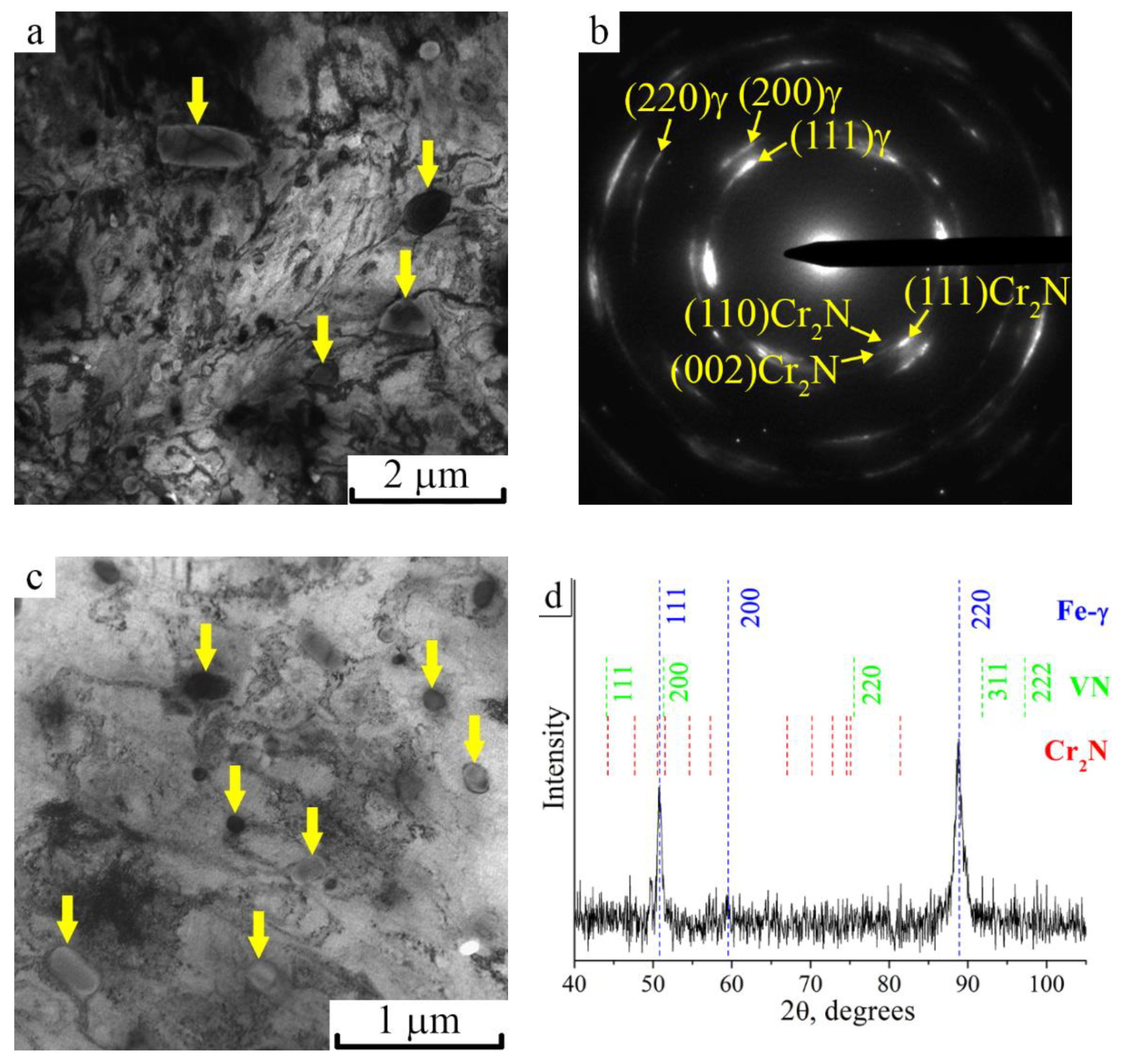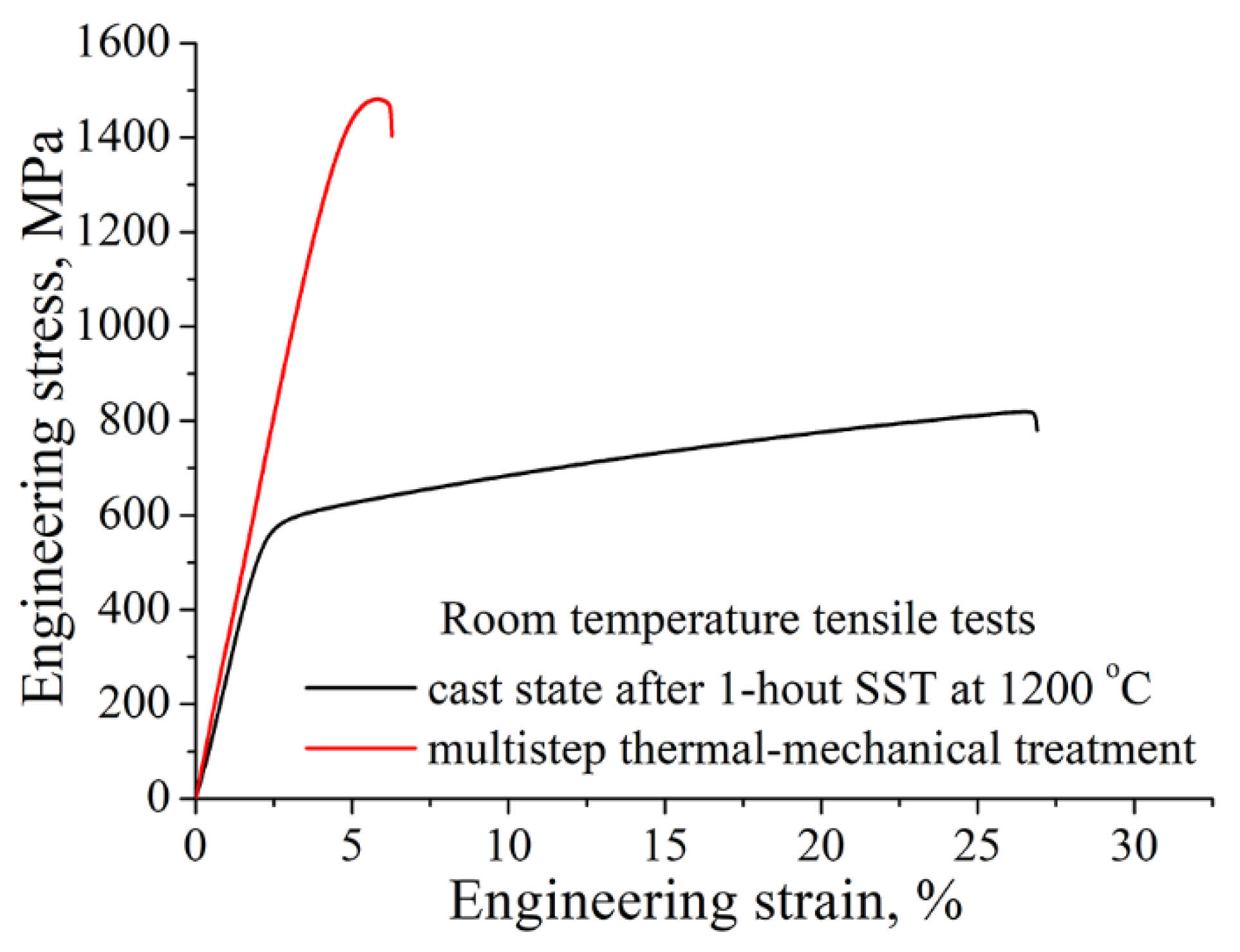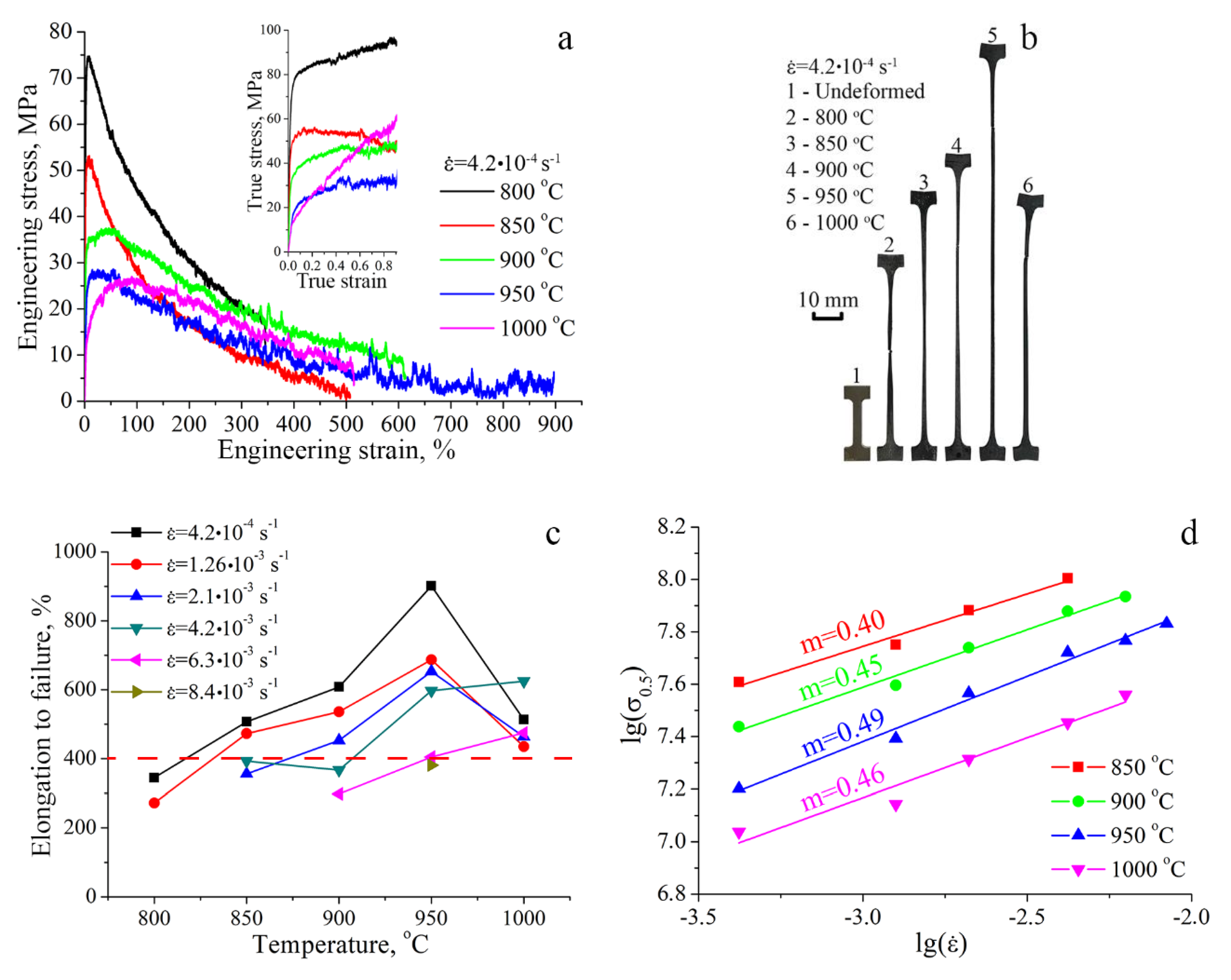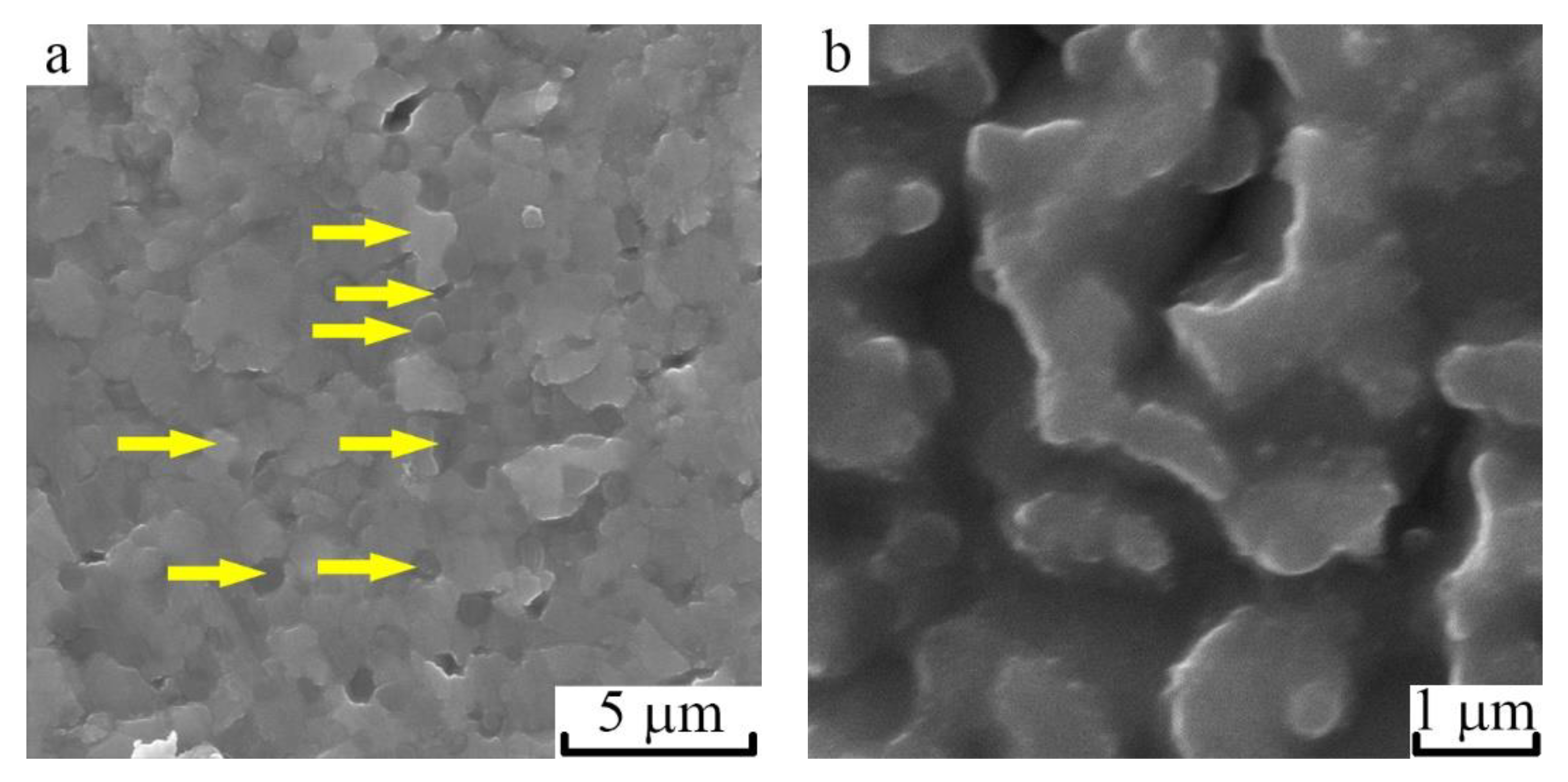On the Superplastic Deformation in Vanadium-Alloyed High-Nitrogen Steel
Abstract
1. Introduction
2. Materials and Methods
3. Results and Discussion
4. Conclusions
Author Contributions
Funding
Conflicts of Interest
References
- Padmanabhan, K.A.; Prabu, S.B.; Mulyukov, R.R.; Nazarov, A.; Imayev, R.M.; Chowdhury, S.G. Superplasticity: Common Basis for a Near-Ubiquitous Phenomenon; Springer-Verlag GmbH: Berlin, Germany, 2018. [Google Scholar]
- Kaibyshev, O.A. Superplasticity of Alloys, Intermetallides and Ceramics; Springer-Verlag GmbH: Berlin, Germany, 1992. [Google Scholar]
- Kawasaki, M.; Langdon, T.G. Superplasticity in Ultrafine-Grained Materials. Rev. Adv. Mater. Sci. 2018, 54, 46–55. [Google Scholar] [CrossRef]
- Langdon, T. An evaluation of the strain contributed by grain boundary sliding in superplasticity. Mater. Sci. Eng. A 1994, 174, 225–230. [Google Scholar] [CrossRef]
- Maehara, Y.; Langdon, T.G. Superplasticity of steels and ferrous alloys. Mater. Sci. Eng. A 1990, 128, 1–13. [Google Scholar] [CrossRef]
- Goldberg, A.; Ruano, O.A.; Sherby, O.D. Development of ultrafine microstructures and superplasticity in Hadfield manganese steels. Mater. Sci. Eng. A 1992, 150, 187–194. [Google Scholar] [CrossRef]
- Cao, W.; Huang, C.; Wang, C.; Dong, H.; Weng, Y. Dynamic reverse phase transformation induced high-strain-rate superplasticity in low carbon low alloy steels with commercial potential. Sci. Rep. 2017, 7, 9199. [Google Scholar] [CrossRef]
- Han, J.; Kang, S.-H.; Lee, S.-J.; Kawasaki, M.; Lee, H.-J.; Ponge, D.; Raabe, D.; Lee, Y.-K. Superplasticity in a lean Fe-Mn-Al steel. Nat. Commun. 2017, 8, 751. [Google Scholar] [CrossRef]
- Özdemir, N.; Orhan, N. Investigation on the superplasticity behavior of ultrahigh carbon steel. Mater. Des. 2006, 27, 706–709. [Google Scholar] [CrossRef]
- Li, S.; Ren, X.; Ji, X.; Gui, Y. Effects of microstructure changes on the superplasticity of 2205 duplex stainless steel. Mater. Design. 2014, 55, 146–151. [Google Scholar] [CrossRef]
- Zhang, H.; Zhang, I.; Cheng, X.; Xu, L.; Bai, B. Superplastic behavior during warm deformation of martensite in medium carbon steel. Scr. Mater. 2010, 62, 798–801. [Google Scholar] [CrossRef]
- Misra, R.D.K.; Hu, J.; Yashwanth, I.V.S.; Challa, V.S.A.; Du, L.-X.; Sun, G.-S.; Xie, H. Phase reverted transformation-induced nanograined microalloyed steel: Low temperature superplasticity and fracture. Mater. Sci. Eng. A 2016, 668, 105–111. [Google Scholar] [CrossRef]
- Zhang, H.; Bai, B.; Raabe, D. Superplastic martensitic Mn–Si–Cr–C steel with 900% elongation. Acta Mater. 2011, 59, 5787–5802. [Google Scholar] [CrossRef]
- Ren, X.; Chen, X.; Xiong, Z. Characterization and analysis of diffusion bonding process in a Cr25Ni7Mo4MnSi duplex stainless steel. J. Manuf. Process. 2018, 34, 603–613. [Google Scholar] [CrossRef]
- Yagodzinskyy, Y.; Pimenoff, J.; Tarasenko, O.; Romu, J.; Nenonen, P.; Hänninen, H. Grain Refinement Process for Superplastic Forming of AISI 301 and 304L Austenitic Stainless Steels. Mater. Sci. Technol. 2004, 20, 925–929. [Google Scholar] [CrossRef]
- Sun, G.S.; Du, L.X.; Hu, J.; Xie, H.; Misra, R.D.K. Low temperature superplastic-like deformation and fracture behavior of nano/ultrafine-grained metastable austenitic stainless steel. Mater. Des. 2017, 117, 223–231. [Google Scholar] [CrossRef]
- Cao, Z.; Wu, G.; Sun, X.; Wang, C.; Ponge, D.; Cao, W. Revealing the superplastic deformation behaviors of hot rolled 0.10C5Mn2Al steel with an initial martensitic microstructure. Scr. Mater. 2018, 152, 27–30. [Google Scholar] [CrossRef]
- Zhang, H.; Ponge, D.; Raabe, D. Superplastic Mn–Si–Cr–C duplex and triplex steels: Interaction of microstructure and void formation. Mater. Sci. Eng. A 2014, 610, 355–369. [Google Scholar] [CrossRef]
- Sagradi, M.; Pulino-Sagradi, D.; Medrano, R.E. The effect of the microstructure on the superplasticity of a duplex stainless steel. Acta Mater. 1998, 46, 3857–3862. [Google Scholar] [CrossRef]
- Song, J.L.; Blackwell, P.L. Superplastic behavior of commercial duplex stainless steel SAF 2304. Mater. Sci. Technol. 1999, 15, 1285–1292. [Google Scholar] [CrossRef]
- Osada, K.; Uekoh, S.; Ebato, K. Superplasticity of As-rolled Duplex Stainless Steel. Trans. Iron Steel Inst. Jpn. 1987, 27, 713–718. [Google Scholar] [CrossRef]
- Gavriljuk, V.G.; Berns, H. High Nitrogen Steels; Springer: Berlin, Germany, 1999. [Google Scholar]
- Reed, R. Nitrogen in austenitic stainless steels. JOM 1989, 41, 16–21. [Google Scholar] [CrossRef]
- Bannykh, O.A.; Blinov, V.M. On the effect of discontinuous decomposition on the structure and properties of high-nitrogen steels and on methods for suppression thereof. Steel Res. 1991, 62, 38–45. [Google Scholar] [CrossRef]
- Blinov, V.M. Progress in the study of high-nitrogen corrosion-resistant aging nonmagnetic vanadium steels. Russ. Metall. (Met.) 2007, 2, 127–135. [Google Scholar] [CrossRef]
- Astafurova, E.; Moskvina, V.; Maier, G.; Melnikov, E.; Galchenko, N.; Astafurov, S.; Gordienko, A.; Burlachenko, A.; Smirnov, A.; Bataev, V.; et al. The effect of test temperature on deformation microstructure and fracture mechanisms in CrMn high-nitrogen steels alloyed (0–3 wt.%) with vanadium. Mater. Sci. Forum 2018, 941, 27–32. [Google Scholar] [CrossRef]
- Astafurova, E.G.; Moskvina, V.A.; Maier, G.G.; Gordienko, A.I.; Burlachenko, A.G.; Smirnov, A.I.; Bataev, V.A.; Galchenko, N.K.; Astafurov, S.V. Low-temperature tensile ductility by V-alloying of high-nitrogen CrMn and CrNiMn steels: Characterization of deformation microstructure and fracture micromechanisms. Mater. Sci. Eng. A 2019, 745, 265–278. [Google Scholar] [CrossRef]
- Astafurova, E.G.; Astafurov, S.V.; Ratochka, I.V.; Mishin, I.P.; Lykova, O.N.; Maier, G.G.; Melnikov, E.V.; Moskvina, V.A. The Influence of Warm abc-Pressing on the Structure and Mechanical Properties of Stable Chromium-Nickel-Molybdenum Steel. Russ. Phys. J. 2018, 61, 1062–1069. [Google Scholar] [CrossRef]
- Mineura, K.; Tanaka, K. Superplasticity of 20Cr−10Ni−0.7N (wt%) ultra-high nitrogen austenitic stainless steel. J. Mater. Sci. 1989, 24, 2967–2970. [Google Scholar] [CrossRef]
- Hyun, H.C.; Kim, M.; Bang, S.; Lee, H. On acquiring true stress–strain curves for sheet specimens using tensile test and FE analysis based on a local necking criterion. J. Mater. Res. 2014, 29, 695–707. [Google Scholar] [CrossRef]
- Tu, S.; Ren, X.; He, J.; Zhang, Z. Stress–strain curves of metallic materials and post-necking strain hardening characterization: A review. Fat. Fract. Eng. Mater. Struct. 2019, 1–17. [Google Scholar] [CrossRef]
- Maier, G.G.; Astafurova, E.G.; Moskvina, V.A.; Melnikov, E.V.; Astafurov, S.V.; Fortuna, A.S.; Galchenko, N.K.; Smirnov, A.S.; Bataev, V.A. Influence of hydrogen-charging on microstructure and microhardness of high-nitrogen austenitic steel processed by high-pressure torsion. AIP Conf. Proc. 2018, 2051, 020182. [Google Scholar]
- Astafurova, E.G.; Tukeeva, M.S.; Maier, G.G.; Melnikov, E.V.; Maier, H.J. Microstructure and mechanical response of single-crystalline high-manganese austenitic steels under high-pressure torsion: The effect of stacking-fault energy. Mater. Sci. Eng. A 2014, 604, 166–175. [Google Scholar] [CrossRef]
- Buken, H.; Kozeschnik, E. A model for static recrystallization with simultaneous precipitation and solute drag. Metallurg. Mater. Trans. A 2017, 48, 2812–2818. [Google Scholar] [CrossRef]









| Strain Rate | 0.42 × 10−3 | 1.26 × 10−3 | 2.1 × 10−3 | 4.2 × 10−3 | 6.3 × 10−3 | 8.4 × 10−3 | m |
|---|---|---|---|---|---|---|---|
| Temperature | δ/σ0.2 | δ/σ0.2 | δ/σ0.2 | δ/σ0.2 | δ/σ0.2 | δ/σ0.2 | |
| 25 | 1.8/1269 | - | - | - | - | - | - |
| 800 | 345/55 | 272/66 | - | - | - | - | - |
| 850 | 507/35 | 473/47 | 356/66 | 393/90 | - | - | 0.40 |
| 900 | 608/25 | 536/37 | 453/48 | 367/68 | 298/71 | - | 0.45 |
| 950 | 901/15 | 687/23 | 653/33 | 597/49 | 405/53 | 381/60 | 0.49 |
| 1000 | 513/11 | 435/13 | 464/18 | 625/24 | 475/31 | - | 0.46 |
© 2019 by the authors. Licensee MDPI, Basel, Switzerland. This article is an open access article distributed under the terms and conditions of the Creative Commons Attribution (CC BY) license (http://creativecommons.org/licenses/by/4.0/).
Share and Cite
Astafurova, E.; Moskvina, V.; Panchenko, M.; Maier, G.; Melnikov, E.; Reunova, K.; Galchenko, N.; Astafurov, S. On the Superplastic Deformation in Vanadium-Alloyed High-Nitrogen Steel. Metals 2020, 10, 27. https://doi.org/10.3390/met10010027
Astafurova E, Moskvina V, Panchenko M, Maier G, Melnikov E, Reunova K, Galchenko N, Astafurov S. On the Superplastic Deformation in Vanadium-Alloyed High-Nitrogen Steel. Metals. 2020; 10(1):27. https://doi.org/10.3390/met10010027
Chicago/Turabian StyleAstafurova, Elena, Valentina Moskvina, Marina Panchenko, Galina Maier, Eugene Melnikov, Kseniya Reunova, Nina Galchenko, and Sergey Astafurov. 2020. "On the Superplastic Deformation in Vanadium-Alloyed High-Nitrogen Steel" Metals 10, no. 1: 27. https://doi.org/10.3390/met10010027
APA StyleAstafurova, E., Moskvina, V., Panchenko, M., Maier, G., Melnikov, E., Reunova, K., Galchenko, N., & Astafurov, S. (2020). On the Superplastic Deformation in Vanadium-Alloyed High-Nitrogen Steel. Metals, 10(1), 27. https://doi.org/10.3390/met10010027






